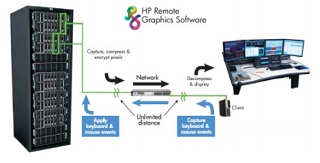The existence of virtualization solutions for providing service to these types of user stations is relatively recent. Solutions have emerged on the market from different manufacturers that make an approach from different perspectives:
-Remote connections to physical graphic stations. In certain platforms, graphic stations are located in the data center, to which users connect by using
optimized remote connection protocols.
-Direct assignment of graphic card. Some hypervisor platforms such as Xen Server or Parallels Workstation Extreme permit physical resources, among which is the
graphic card, to be directly assigned to the virtual graphic stations. In this case, the number of virtual graphic stations run on a server depends on the quantity of PCIe slots on the server base plate.
-Virtualization of GPUS’s. Nvidia provides GPU’s based on Kepler architecture, which permits virtualization of the GPU hardware. With this technology, it is possible for several virtual desktops to share the same physical GPU. The number of graphic stations per server depends on the virtual GPU’s used by each graphic
station.
In these specialized environments, one fundamental point is the selection of the connection protocol for the virtual graphic stations. We will talk about this topic in upcoming articles.







0 Comments